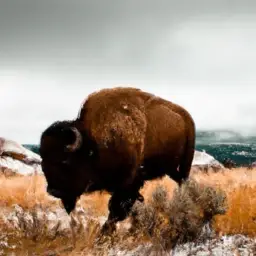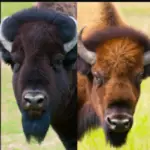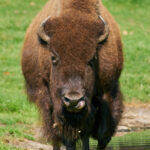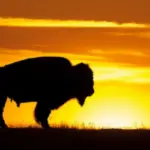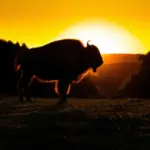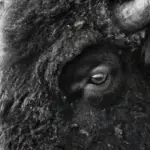Have you ever wondered why bison, these majestic creatures of the wild, sometimes reject their own young? It’s a fascinating question that has puzzled researchers and wildlife enthusiasts alike for many years. In this article, we will explore the intriguing behavior of bison and delve into the possible reasons behind their unexpected rejections. Get ready for an eye-opening journey into the world of these remarkable animals and uncover the mysteries of “Why Do Bison Reject Their Young.”
Understanding Bison’s Social Structure
Bison, also known as American buffalo, live in hierarchical herds that consist of different genders and age groups. The social structure of bison herds is based on a dominant-subordinate relationship, with a clear hierarchy that ensures order and stability within the group.
The hierarchical nature of bison herds
In a bison herd, dominant individuals hold higher social status and exert control over subordinate members. The dominant bull, often referred to as the “alpha” male, is the leader of the herd and has breeding rights with the females. Other male bison in the herd are usually subordinate to the dominant bull and do not have the same opportunities for reproduction.
Among female bison, there is also a hierarchy based on age and social status. Older and more experienced cows tend to have higher social status and often lead the herd, while younger cows are subordinate. The social order within the herd is crucial for maintaining harmony and ensuring the survival of the group.
Roles of different genders and age in bison herds
Each gender and age group in a bison herd plays a specific role. The dominant bull is responsible for defending the herd against predators and other bulls, as well as for mating with receptive females during the breeding season. The subordinate males may assist the dominant bull in defending the herd, but their primary role is to wait for an opportunity to become the dominant male.
Female bison, especially older cows, have an essential role in the social structure. They lead the herd in search of food and water, protect the calves, and teach them social behaviors. Younger cows, which are not yet experienced mothers, learn from the older cows and gradually take on more responsibilities as they age.
A Look at Bison Reproductive Behavior
Bison have a defined mating season, which usually occurs in late summer or early fall. During this time, the dominant bull competes with other males to win the right to mate with receptive females. Mating behavior in bison involves vocalizations, displays of strength, and physical interactions such as charging and pushing.
Mating season and bison behavior
The mating season brings about significant changes in bison behavior. The dominant bull becomes more aggressive, often engaging in intense battles with rival males to establish his dominance. This aggression extends to other members of the herd, as the dominant bull may exhibit heightened territorial behavior and limit the movement and activities of other males.
Female bison display receptive behaviors, such as seeking the attention of the dominant bull and allowing him to approach and mate with them. Once a female becomes pregnant, she will eventually separate herself from the rest of the herd to give birth to her calf.
Birth and the importance of mother-calf bond
The birth of a bison calf is a crucial event in the herd’s dynamics. The mother-calf bond is incredibly strong, and the survival of the calf depends heavily on its relationship with its mother. Immediately after giving birth, the mother cleans and nurtures the calf, forming a vital bond that ensures the calf’s social and physical development.
The mother-calf bond is characterized by close physical contact, vocal communication, and mutual recognition. The calf remains close to its mother for protection, learning essential survival skills, and receiving nourishment through nursing. This bond is critical for the calf’s growth, as it prepares the young bison for integration into the herd and future reproductive success.
Causes for Bison Mother-Young Rejections
While the mother-calf bond is typically strong in bison herds, there are instances when a mother may reject her young. Several factors can contribute to this rejection, ranging from environmental stress to physiological causes and even inexperience.
Analyzing various factors resulting in rejections
Environmental stressors can play a significant role in triggering mother-young rejections in bison. Disruptions in the herd’s habitat, such as food scarcity, unusual weather patterns, or human disturbances, can increase stress levels in the herd. This heightened stress can contribute to a breakdown in the mother-calf bond, leading to rejection.
Illness or injury in the calf can also result in rejection by the mother. If the mother perceives that the calf is not physically fit or in optimal health, she may instinctively reject it to allocate resources and attention to healthier offspring.
Recognizing the signs of Bison mother’s rejection
Recognizing the signs of a mother’s rejection is crucial for understanding and intervening in such situations. A rejected calf may be abandoned or neglected by its mother, leading to insufficient care, insufficient milk intake, and reduced chances of survival. The mother may show signs of aggression towards the calf, actively disregarding or pushing it away, or displaying avoidance behaviors.
Understanding these signs and monitoring mother-young interactions can help identify potential rejections early on and implement measures to prevent further harm to the calf.
Stress and Its Relation to Rejection
Stress has a profound impact on bison behavior, including the mother-young relationship. Environmental stressors or disturbances can affect the emotional and physiological well-being of bison, potentially leading to increased instances of mother-young rejections.
Impact of environmental stress on bison
Bison are highly adapted to their natural habitat, and any alterations or disturbances to their environment can cause stress. Factors such as habitat loss, human encroachment, predators, or extreme weather conditions can disrupt the herd’s daily routines and increase overall stress levels.
In turn, elevated stress levels can negatively impact the mother-young relationship, triggering a rejection response from the mother. Stress-induced changes in behavior and hormonal fluctuations can disrupt the mother’s ability to form or maintain a strong bond with her calf.
Stress-induced rejection of young bison
When bison experience high levels of stress, their nurturing and protective instincts may become impaired. This can result in a lack of bonding or maternal behaviors towards their young, leading to rejection. The causes of stress-induced rejections can be both direct and indirect, with stress affecting the mother’s behavior or physiological condition.
Reducing environmental stressors and promoting a calm and stable habitat for bison herds can help mitigate the risk of stress-induced rejections. Conservation efforts and the establishment of protected areas can contribute to providing a suitable environment for bison, reducing the likelihood of stressful situations that may lead to mother-young rejections.
Physiological Causes of Rejection
In addition to external stressors, physiological factors can contribute to mother-young rejections in bison. Both illness and injury in calves, as well as maternal health, can influence the mother’s propensity to reject her young.
Illness and injury in calves leading to rejection
If a calf is born with significant health issues or sustains an injury shortly after birth, the mother may perceive it as a threat to the survival of the herd or deem it unlikely to thrive. Bison possess a natural instinct to prioritize the well-being of the herd as a whole, making them more likely to reject offspring that they believe may compromise the group’s overall fitness.
Furthermore, illnesses that affect the calf’s appearance, mobility, or behavior can trigger a rejection response from the mother. Recognizing and addressing potential health issues promptly can help prevent rejections due to physiological causes.
Maternal health affecting rejection tendency
The physiological condition of the mother also plays a role in the likelihood of a young bison being rejected. If a mother experiences health issues or is in a weakened state, she may be less capable of providing the care and attention required for her calf’s survival. This can result in rejection as the mother prioritizes her own well-being or focuses on the care of healthier offspring.
Maintaining the overall health and welfare of both the mothers and the calves is essential for reducing instances of rejection due to physiological causes. Management practices that support the well-being of bison herds, such as ensuring adequate nutrition and prompt veterinary care, can contribute to a higher success rate of mother-young bonding.
Role of Inexperience in First-time Bison Mothers
Inexperience can also play a significant role in mother-young rejections among bison. Like many other species, bison may make mistakes or exhibit insufficient maternal behaviors during their first-time motherhood.
The learning curve of motherhood for bison
First-time mothers, whether bison or any other mammal, must navigate the challenges of motherhood without prior experience. The learning curve can be steep, and the instinctual behaviors necessary for successful rearing of offspring may take time to develop fully.
Younger bison mothers may struggle with recognizing and responding to their calf’s needs, resulting in inadequate care or mismothering behaviors. These mistakes are typically not intentional but rather a consequence of inexperience.
Mistakes made by first-time mothers resulting in rejection
In some cases, the mistakes made by first-time mothers can lead to the rejection of their young. These mistakes may include improper nursing, failure to protect the calf from predators, or the inability to establish a strong bond due to a lack of understanding or instinctual responses.
While the rejection of a calf by a first-time mother is unfortunate, it does not necessarily mean that the mother will reject future offspring. With each subsequent birth, bison mothers often gain experience and knowledge that improves their mothering abilities.
The Influence of Human Disturbance
Human disturbance in bison territory can have significant effects on the behavior and dynamics of bison herds. Increased human activities and encroachment on their habitat can disrupt their natural behaviors and potentially lead to mother-young rejections.
Effects of human disturbing bison territory
Bison are naturally wary of human presence and often view it as a threat. Human activities, such as recreational activities, habitat fragmentation, or direct conflicts, can cause stress and fear among bison herds. This disturbance can interfere with the mother’s ability to form a strong bond with her calf and may increase the likelihood of rejection.
Furthermore, human disturbance can result in alterations to the herd’s habitat, including food scarcity or the disruption of migration patterns. These changes can lead to stress-induced rejections or diminish the overall well-being of bison herds.
Cases of rejection due to human disturbance
Instances of mother-young rejections directly attributed to human disturbance have been observed in wild bison populations. The increased presence of humans in bison territory may cause agitated behavior in the herd, leading to disrupted mother-calf bonding and the subsequent rejection of the calves.
It is essential for conservationists, park staff, and visitors to respect the natural behaviors and habitat of bison, minimizing disturbances and ensuring their well-being. Education and awareness campaigns can help promote responsible human behavior around bison, reducing the risk of rejections caused by human disturbance.
Survival Implications for Rejected Young Bison
For a rejected young bison, the chances of survival and integration into the herd are significantly diminished. Without the care and protection of the mother, these calves face numerous challenges and obstacles in their quest for survival.
Life prospects for rejected bison
Rejected young bison often struggle to thrive without the guidance and care of their mother. Their chances of survival decrease due to a lack of nourishment, vulnerability to predators, and the absence of social support from the herd.
Additionally, rejected calves may face difficulties in learning essential survival skills, such as finding food and water sources or navigating the herd’s dynamics. The absence of social interactions and learning opportunities within the herd can hinder their development and adaptation to the natural environment.
Role of other herd members towards rejected young
Although the presence of a nurturing mother is essential, other herd members can also contribute to the survival and well-being of rejected young bison. Adult females in the herd may demonstrate alloparental behaviors, providing additional care and attention to the orphaned calf. This communal care can improve the chances of survival and integration for rejected calves by offering them a substitute mother figure.
Furthermore, older experienced cows may serve as mentors to the rejected calf, teaching them important social skills and survival strategies. The social interactions and acceptance from other herd members can play a critical role in the rejected calf’s ability to adapt and find its place within the herd.
Possible Interventions for Rejected Young Bison
When mother-young rejections occur in bison herds, interventions may be necessary to ensure the well-being and survival of the rejected calf. Conservationists and park staff play a vital role in implementing suitable measures to address these situations effectively.
Roles of conservationists and park staff
Conservationists and park staff are responsible for the management and welfare of bison populations. When mother-young rejections are observed or suspected, their expertise and intervention are crucial. They can intervene by monitoring the situation, assessing the calf’s condition, and determining the best course of action to improve its chances of survival.
Conservationists and park staff can also play a role in reducing environmental stressors and human disturbance, which are major factors contributing to mother-young rejections. Implementing conservation strategies, such as securing protected areas, managing habitat quality, and raising public awareness, can help create a conducive environment for successful mothering and calf rearing.
Methods of reintervention for rejected young
To give the rejected young bison a fighting chance, various methods of reintervention can be employed. These approaches aim to replicate the care, protection, and social interactions that the calf would have received from its mother.
One possible method is the establishment of surrogate dams, where a female bison who has lost her own calf may be paired with the rejected calf. This surrogate mother can provide the necessary care and guidance, increasing the calf’s chances of survival and integration into the herd.
Another option is hand-rearing the rejected calf with appropriate veterinary care, nutrition, and socialization. This method requires extensive resources and expertise but may be necessary in cases where surrogate dams are not available or suitable.
Interventions should be designed and implemented cautiously, considering the specific circumstances and needs of each rejected young bison. Long-term monitoring and evaluation are crucial to assess the success and welfare of reintervened calves.
Does Bison Mating Behavior Influence How They Treat Their Young?
Bison mating habits explained: The mating behavior of bison does influence how they treat their young. Males compete for dominance during mating season, but once the calf is born, males become more protective. Females also show nurturing behavior towards their young, creating a balanced family dynamic within the bison herd.
Implications for Bison Population and Conservation Efforts
Mother-young rejections in bison herds can have significant implications for the overall population and conservation efforts. Understanding the causes and consequences of rejections is essential for designing effective strategies to safeguard the future of bison populations.
Effects of young rejection on bison population
Rejections contribute to the decrease in the number and survival rates of bison calves. As rejected young bison face significant challenges in their quest for survival, the overall recruitment rate in the population can be negatively affected. This decline in recruitment can lead to a smaller and less robust population over time, potentially impacting the genetic diversity and resilience of the species.
Incorporating knowledge of rejection into conservation strategies
Knowledge of mother-young rejections can inform and shape conservation strategies for bison populations. Management plans need to consider the potential causes of rejections, such as environmental stressors and human disturbances, and address them to minimize their impact on mother-calf bonding.
Conservation efforts should also focus on promoting the health and well-being of both the mothers and the calves, ensuring optimal conditions for successful rearing. Measures may include habitat preservation, reducing human disturbance, and monitoring the social dynamics within bison herds to detect and address potential issues early on.
By incorporating this knowledge into conservation strategies, we can strengthen the chances of the bison population’s growth and long-term viability. Protecting and preserving the unique social structure and reproductive behavior of bison is vital for their survival and contributes to the overall conservation of this iconic species.

